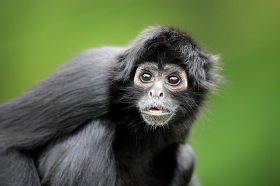
Black-Headed Spider Monkey
Ateles fusciceps
Animal Behavior: Black-headed spider monkeys are active during the day, sleep at night, and spend most of their time in the trees. These monkeys associate in loose groups of about 20 individuals, but it is rare to find them gathered in one place. Individuals drift between subgroups of varying sizes. They move through the forest using both their hands and feet to swing between trees and walk in an upright position along branches. Black-headed Spider Monkeys can leap in excess of 9 meters (30 ft.) from branch to branch.
Eating Habits: Black-headed Spider Monkeys prefer ripe fruits and leaves, but will eat nuts, seeds, insects, and sometimes eggs. The climate of the rainforests in which they live ensures an abundant supply of food year-round, allowing them to be able to reside in the same area throughout the year.
Range: Black-headed Spider Monkeys are found in the rainforests of Central and South America. The majority of their time is spent in the uppermost branches of trees, foraging for food. Most climates allow them to live year-round in the same area. However, in drier habitats, they must travel up 18 km (10 mi.) each day in search of food.
Conservation Efforts: One of the main reasons Black-headed Spider Monkeys are declining in numbers is due to deforestation of their habitat. Some of the monkeys are able to survive in areas that have been partially logged, but few can live where rainforests have been completely removed.
Animal Facts: Their tail is much longer in length than their body. The tail measures 70 to 85 cm (28 to 34 in.) while the body ranges from 40 to 55 cm (16 to 22 in.). The average weight for both the male and female is approximately 9 kg (20 lbs.). Black-headed Spider Monkeys can be separated into two subspecies. The subspecies A. f. fusciceps has a brownish-black body with a brown head. A. f. robustus is completely black except for a few white strands of hair on the chin. Their coat is long and shaggy, usually with a lighter underside. A white ring surrounds each eye. Their skull is structured so that they have forward facing eyes which allow them to precisely gauge distances as they swing from tree to tree. The hands and feet of A. fusciceps are adapted for climbing. Black-headed Spider Monkey species lack a thumb, which increases the strength of their grip and helps with climbing.
